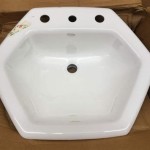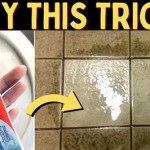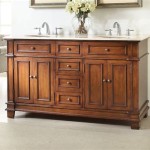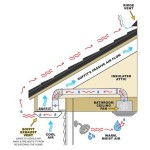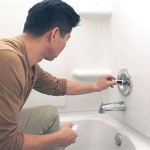Vintage Blue Bathroom Vanity: A Guide to Timeless Elegance
A vintage blue bathroom vanity represents a fusion of practicality and aesthetic appeal, offering a unique way to incorporate character and color into a space often dominated by purely functional considerations. The resurgence of interest in vintage design, particularly in the realm of interior decorating, has placed these vanities in high demand. The color blue, with its calming and versatile properties, further enhances the appeal, making it a popular choice for homeowners seeking to create a serene and stylish bathroom environment.
The term "vintage" in this context typically refers to vanities that either are genuinely old, often repurposed from antique furniture, or are newly manufactured items designed to replicate the look and feel of bygone eras. These designs can draw inspiration from various periods, including Victorian, Art Deco, Mid-Century Modern, and farmhouse styles. The blue hue can range from a pale, washed-out robin's egg blue to a deep, saturated navy, each shade evoking a different mood and complementing a diverse range of bathroom decor styles.
Choosing a vintage blue bathroom vanity involves various considerations, from understanding the differences between genuine vintage pieces and reproductions to evaluating the functionality and longevity of different materials. Furthermore, carefully selecting the right shade of blue, considering hardware options, and coordinating the vanity with other bathroom elements are crucial steps in achieving the desired aesthetic. This article aims to provide a comprehensive guide to navigate the world of vintage blue bathroom vanities, encompassing their historical context, design aspects, practical considerations, and integration into a broader bathroom design scheme.
Understanding the Appeal of Vintage
The appeal of vintage bathroom vanities extends beyond mere aesthetics; it embodies a connection to the past, a rejection of mass-produced uniformity, and a desire for unique, personalized spaces. Vintage pieces often boast intricate detailing, solid construction, and a patina that speaks to their history. The character imbued in these vanities provides a counterpoint to the sleek, minimalist designs prevalent in contemporary bathrooms.
Repurposing antique furniture into bathroom vanities is a common practice. Dressers, sideboards, and even old desks can be transformed into functional and stylish focal points. This approach not only gives new life to discarded items but also allows for customization to suit specific space requirements and personal preferences. However, repurposing requires careful consideration of plumbing and structural modifications to ensure functionality and safety.
While genuine vintage pieces possess an inherent charm, they may also come with inherent challenges. Wear and tear, limited storage capacity, and compatibility with modern plumbing systems are factors that need to be considered. Replacements, while often inspired by older styles, provide increased conveniences while often retaining aesthetic similarities to older styles.
Reproductions of vintage vanities offer the best of both worlds – the aesthetic appeal of vintage design combined with the convenience and functionality of modern construction. These vanities are typically made with new materials and feature updated plumbing connections, ample storage space, and durable finishes. However, it's important to choose reproductions carefully, ensuring that they capture the essence of vintage design without sacrificing quality or authenticity.
Navigating the Spectrum of Blue Hues
The versatility of the color blue is one of its greatest assets in interior design. Ranging from serene pastels to bold, dramatic shades, blue can evoke a variety of moods and complement a wide range of styles. When choosing a blue hue for a vintage bathroom vanity, several factors should be considered, including the size and lighting of the bathroom, the overall color palette, and the desired aesthetic.
Light blue shades, such as robin's egg blue, powder blue, and pastel blue, create a calming and airy atmosphere, making them ideal for smaller bathrooms or spaces with limited natural light. These hues reflect light effectively, making the room feel brighter and more spacious. They also pair well with white, cream, and other light-colored accents, contributing to a clean and refreshing look.
Medium blue shades, such as classic blue, denim blue, and cornflower blue, offer a balanced and versatile option that works well in a variety of bathroom sizes and styles. These hues provide a pop of color without being overwhelming and can be paired with both light and dark accents. They also complement a range of hardware finishes, from brushed nickel to antique brass.
Dark blue shades, such as navy blue, indigo, and teal blue, create a dramatic and sophisticated look, adding depth and character to the bathroom. These hues are best suited for larger bathrooms with ample natural light, as they can make smaller spaces feel darker and more enclosed. They pair well with white, gold, and other luxurious accents, contributing to a rich and opulent aesthetic. When incorporating a dark blue vanity, it's vital to ensure adequate lighting to counteract any potential dimming of the room's overall brightness.
Beyond the specific shade of blue, the finish of the vanity also plays a crucial role in its overall aesthetic. A distressed or antiqued finish can enhance the vintage character, while a glossy or lacquered finish can create a more modern and polished look. The choice of finish should be carefully considered in relation to the overall style of the bathroom.
Practical Considerations: Materials, Storage, and Plumbing
Beyond the aesthetic appeal, the functionality and durability of a vintage blue bathroom vanity are paramount. Selecting the right materials, assessing storage needs, and ensuring compatibility with existing plumbing systems are essential steps in the decision-making process. A vanity crafted from materials unsuitable for a bathroom environment is liable to deteriorate over a short span of time as a result of high humidity and splashes of water.
Solid wood is a popular choice for vintage vanities due to its durability, natural beauty, and ability to be easily refinished. However, it's important to choose hardwoods that are resistant to moisture damage, such as oak, maple, or cherry. Proper sealing and finishing are also essential to protect the wood from water damage and warping. Painted surfaces need to be maintained and touched up over time to prevent water damage from compromising the wood beneath. Wood veneers are a more affordable option that can mimic the look of solid wood, but they are less durable and may be prone to peeling or cracking.
Engineered wood products, such as plywood and MDF (medium-density fiberboard), are also commonly used in vanity construction. These materials are more affordable than solid wood and are less prone to warping or cracking. However, they are also less durable and may be more susceptible to water damage. When using engineered wood products, it's important to choose high-quality materials that are properly sealed and finished.
The storage capacity of a bathroom vanity is another crucial consideration. Assess your storage needs and choose a vanity that provides adequate space for toiletries, towels, and other bathroom essentials. Consider vanities with drawers, cabinets, and open shelving to maximize storage options. Also, the internal configuration of the storage elements must consider both the existing plumbing and the users' storage styles.
Ensuring compatibility with existing plumbing systems is essential to avoid costly and time-consuming renovations. Measure the location of the existing plumbing pipes and choose a vanity that accommodates these measurements. Consider the location of the drain, water supply lines, and shut-off valves. It may be necessary to modify the plumbing to accommodate a new vanity, but this should be done by a qualified plumber to ensure proper installation and prevent leaks. If the choice is made to incorporate modern plumbing elements into an older piece of furniture, it is possible further modifications may be necessary beyond just the plumbing fixture installation.
The countertop is another very important consideration. Marble, Quartz, Granite and Quartzite, along with solid surface materials like Corian all serve as suitable options in modern bathrooms. Depending on the vanity itself, the top may need to be custom cut to fit. If this is the case, it is important to acquire very precise measurements.
Finally, hardware will have a strong visual impact on the overall aesthetic of the piece itself. Knobs, pulls, and even faucets will play a key role in finishing the vanity's look. Pay attention to materials, styles, and finishes and how they will blend in with the bathroom.
By carefully considering the historical context, design aspects, practical considerations, and integration into a broader bathroom design scheme, one can ensure the selected vintage blue bathroom vanity adds both utility and beauty to the desired space for many years to come.

Blue Bath Vanity Drawers With Antique Brass Knobs Transitional Bathroom

Pin On Bathroom Spaces

Cora 72 Inch Blue Wood Double Bathroom Sink Vanity Vtb

Vintage Dresser Blue And White Bathroom Shabby Chic Bathrooms Dressers

Navy Blue Bath Vanity With Antique Brass Vintage Faucet Transitional Bathroom

Adelina 34 Inch Vintage Bathroom Vanity Light Blue Finish

Vintage Dresser Blue And White Bathroom The Lilypad Cottage

49 Benton Collection Vintage Blue Cottage Glennville Bathroom Sink Va Bentoncollections

Westminster Wall Hung Vintage Blue Vanity Designer Bathware

34 Benton Collection Daleville Vintage Blue Shabby Chic Bathroom Vanity Hf 081y Com
Related Posts

